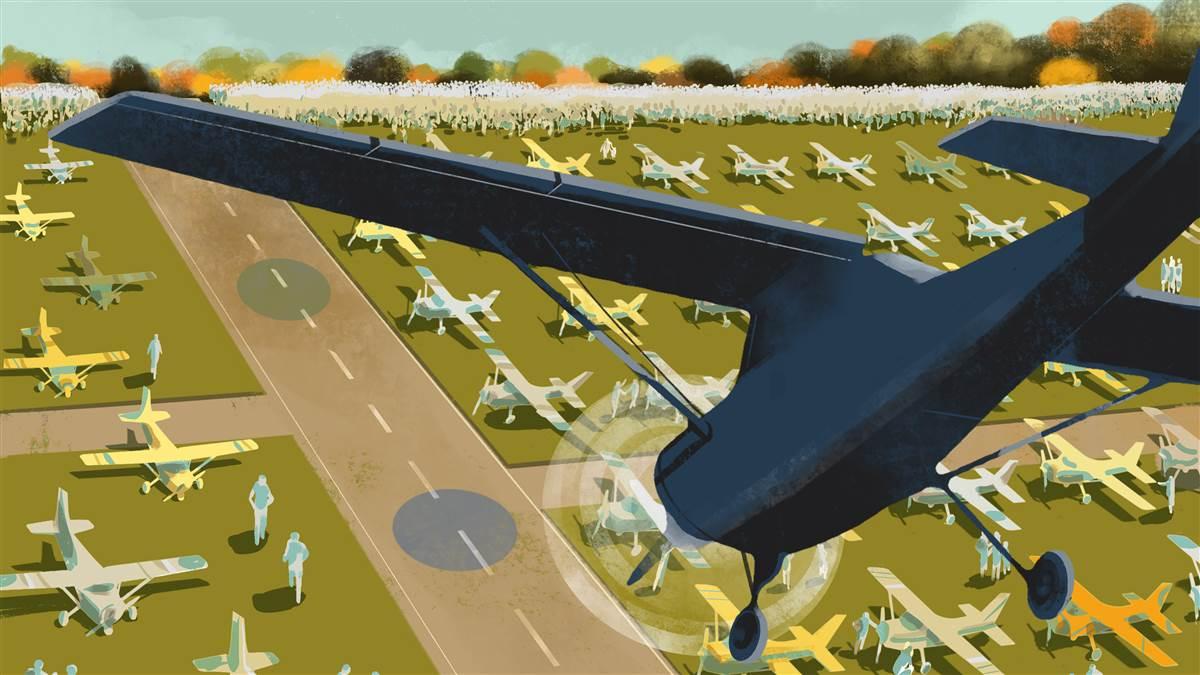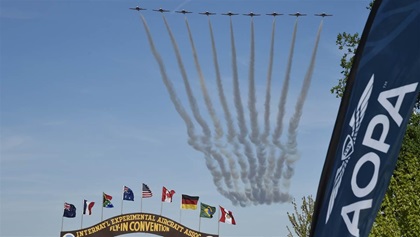Oshkosh here we come
Are you ready to land at the world’s biggest airshow?

The weather looks VFR for the whole week; the airplane is running smoothly and is full of fuel; weight and balance checked and checked again. You’re about to put your Out of Office email message on: “Off to spend a week with 700,000 new friends. See you at Oshkosh!” You’re ready!
Are you really? We talked to pilots who have flown the Fisk Arrival many times; worked on the annual 40-page document that governs the arrival and departure procedures; or have witnessed just about every right and wrong way to touch down at EAA AirVenture during the nation’s biggest airshow in Oshkosh, Wisconsin. Here are their tips and takeaways.
It starts with the notam
VFR and IFR arrivals to Wittman Regional Airport (OSH) during AirVenture are governed by a notice to air missions published in the weeks leading up to the event. There are distinct arrival procedures for helicopters, ultralights, and turbines or warbirds, but most VFR traffic will follow the instructions laid out in the notice for what’s known as the “Fisk Arrival.”
The first time you review the notice should not be en route to the first waypoint in the Fisk Arrival. As soon as the notice becomes available, download or print it and start reviewing it. Here you’ll find all the arrival and departure procedures, radio frequencies, airport details, and more. Longtime EAA volunteer Fred Stadler said 2023’s notice is not expected to have many changes, but don’t get complacent.
Lin Caywood of Frederick, Maryland, said she builds a checklist specifically for the arrival and departure procedures each year. She starts by reviewing the latest notam, then pulls out pertinent waypoints and frequencies so this important information will be highlighted and easy to find rather than flipping through 32 to 40 pages. Caywood, who’s flown her Cessna 182T more than a dozen times to the show, likes to have a passenger to help look for traffic and cue her what’s next on the checklist. That lets her keep eyes outside at a critical point when the volume of traffic can be heavy.
Be flexible with your arrival day
“The time that you think is the best time to come is probably the time that everyone else thinks is the best time to come,” said Stadler, who lives in Oshkosh and flies a Glasair GlaStar. (You may have seen him fly the Fisk Arrival in one of EAA’s instructional videos.) Planning to come in on Saturday, but after the mass arrivals? Yeah, everybody knows about that. And Sunday also sees a huge push of arriving traffic as people try to get in before the show officially starts on Monday.
"Somebody can be 10,000 hours and be supremely confident and not be ready to fly into Oshkosh."EAA has added more general aviation parking and encourages pilots to arrive later in the week by including a second night airshow, Stadler said. “You can come in Wednesday, Thursday, or Friday and have as good an experience and it’s a piece of cake coming and going,” Stadler said. Just know that you’ll need to be on the ground before the airspace closes for afternoon airshows.
Slower flight, shorter landings
Flying at 90 knots at 1,800 feet msl—the speed and altitude most aircraft will fly throughout the Fisk Arrival—sounds simple to do, but many pilots can’t sustain that without climbing or descending. Can you? Go fly five or six miles at 90 knots and see the power and trim settings that work best.
You will likely be flying faster or slower than you would on approach to your own airport. If you’re behind someone going slower than you, you will need to match their speed to stay the requisite half-mile behind them—and that can add another level of complexity to your approach.
The Fisk Arrival instructs pilots to pick out visual references as you approach the airport from the city of Ripon, including railroad tracks that you’ll navigate over. If you have a GPS bias, practice picking out these kinds of landmarks where you fly before you try it at Oshkosh.
Which dot? That dot
Each runway at OSH has its own approach procedure. Even after you’ve been assigned a runway and given a frequency to monitor, things can change. Situational awareness, always important, becomes crucial.
The tower controller will instruct you to land on a colored dot on your assigned runway. Here’s where precision landing skills are needed. It’s important to touch down on that dot, and not the other ones. This allows the controller to land aircraft on the same runway simultaneously.
People can and do land on the wrong dot. “If they tell the person in front of you to land on the yellow dot and they don’t know how to land precisely, they blow past it—if you’re right behind that guy, ATC will change where they want you to land because that guy messed up,” said Jim Cunningham, a flight instructor in Oshkosh.
And speaking of landing, Cunningham said, don’t let weather conditions force you into a bad situation. “We see a fair number of fender benders every year because the weather conditions are forcing people to land with a hefty crosswind or in some cases a slight tailwind,” he said.
If you plan to have a flight review before going to AirVenture, mention that to your CFI, Stadler suggested. “Practice flying another 1,000 feet down the runway. Those kinds of last-minute changes that somebody should be prepared for. Fly a right traffic pattern,” he said, noting that the approach to Runway 27 at OSH is right-hand traffic and includes a descent on the downwind and base legs.
Know when not to
Not everyone should try to fly into Oshkosh during the big airshow, said Stadler. He’s not as concerned with low-time pilots as he is with high-time, IFR-only pilots who are used to “extensive hand holding,” he said, or have never done an approach that includes a descending turn. “Somebody can be 10,000 hours and be supremely confident and not be ready to fly into Oshkosh,” he said. “Your average just-minted private pilot is probably more familiar with maneuvering the airplane at different airspeeds than the high-time IFR pilot.”
At the least, have an alternate in place and ready to go if the stars don’t align—or a runway suddenly closes—or there’s just too much going on for your comfort zone. There’s always Fond du Lac County Airport (FLD) or Appleton International Airport (ATW), although ATW gets congested. Nobody watching the inbound traffic at OSH keeps track of pilots who deviate—but they sure know who’s pranged a propeller or a wing tip.
eaa.org/airventure

 Going to EAA AirVenture? Visit AOPA on the flight line across from the brown arch and let us help you get the most out of your membership.
Going to EAA AirVenture? Visit AOPA on the flight line across from the brown arch and let us help you get the most out of your membership.

